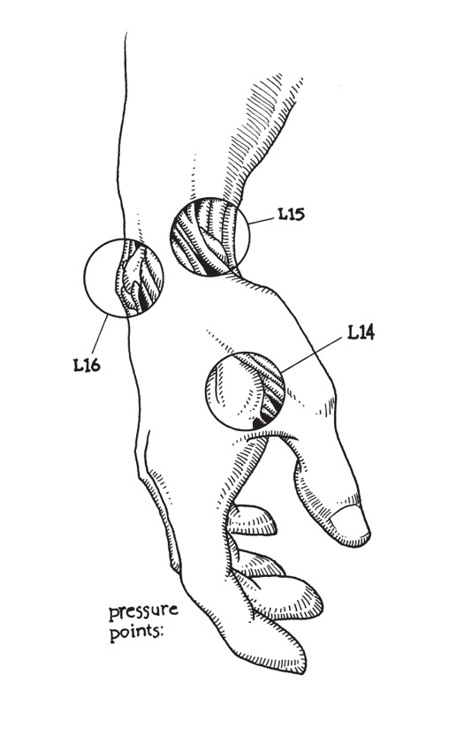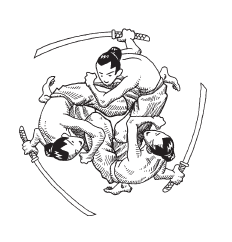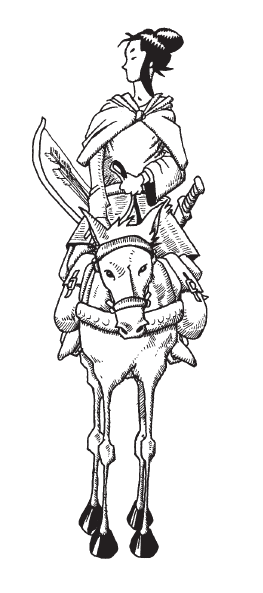
Yasutsune “Ankoh” Itosu was an Okinawan martial artist. He worked as a secretary to the king of Okinawa and studied karate under Sokon Matsumura, the head of the king’s bodyguards. When a new Okinawan public school system was opened, Itosu suggested that karate be taught as a part of physical education classes. He believed that young students who study karate learn not only how to defend themselves but also how to stay healthy and live peacefully in society. In 1901, he became the first teacher to teach karate in the schools.
Itosu was an average-sized man. He didn’t look like an athlete, but had a muscular chest and arms and legs that were much stronger than they looked. He was known for his ability to take a punch and for his powerful hands that could crush a green bamboo stalk.
The bully was young and strong the day he picked a fight with Ankoh Itosu. Despite that strength, the fight was the stupidest (and last) street fight of his life.
As bullies often do, Kojo thought he was toughest guy in town. He practiced fighting with a group of young men every evening after work. Each evening they practiced techniques with one another, and then each weekend they went downtown to the waterfront district in Naha, the local port city. There they’d find sailors, dockworkers, and laborers who had come to town for a good time. Some of them would be drinking too much. None of them would need much of a nudge to fight. Kojo and his friends would pick a fight and try out their newest techniques. Sometimes they’d win. Sometimes they’d lose. Each time they’d take what they learned home, work on it to make it more effective, then go back to town the next weekend to try it out again.
The first time Kojo saw Ankoh Itosu was one of those weekends. He and his friends had gone down to the waterfront to meet a ship that had just come in. An old man was standing on the dock talking to one of the sailors.
“If you want a challenge, try him,” Kojo’s friend said to him, pointing to the old man.

“Why?” Kojo asked. “He doesn’t look so tough to me.” “That’s Itosu,” his friend said.
“Itosu the karate master?” Kojo could hardly believe his ears. The man had a long gray beard and deep wrinkles in the corners of his eyes. He was at least thirty years older than the oldest of Kojo’s gang, and he was several inches shorter and several pounds lighter than Kojo himself. “He doesn’t look so tough,” Kojo said.
“Try him,” the friend said, a dare in his eyes.
“It would be good for bragging rights,” Kojo thought, for at that time he was still thinking like a bully. “I could say that I beat the great Ankoh Itosu. Even if I couldn’t beat him, if I could just get one good punch in on him, it would make me respected, admired among my friends.” The bully watched Itosu point to a nearby restaurant and bow to the person he had been talking to.
“Wait over there,” Kojo said to his friends, motioning to a spot across the street. “Watch closely. You may learn something.” They grinned and trotted off.
The bully figured that his best bet was to catch Itosu by surprise. He walked quietly around the corner of the restaurant, flattened himself against the front of the building, waited for Itosu to come around to the entrance. Soon he heard footsteps on the gravel. Itosu was going to walk right past Kojo’s corner. Kojo rubbed his knuckles and smiled to himself.
Itosu rounded the corner. Without warning, the bully sprang out from the shadows. With a loud cry, he wound up and threw his best punch. Itosu’s head snapped around as he saw the punch coming. But rather than block he just let out a noise that sounded a little like “Ummph.” The bully had his full weight behind the punch and landed it on Itosu’s ribs just in front of his left arm. It landed hard, but simply bounced off. With a movement so quick he didn’t even see it, Itosu grabbed the bully’s punching hand and tucked it under his left arm. The pain shot up the bully’s arm like a lightning bolt.
“And who might you be?” Itosu asked.
“I’m—I’m Kojo,” the bully replied, gasping for breath against the pain. “Actually, Kojiro. My friends call me Kojo.” His friends. Where were his friends? Out of the corner of his eye, he saw them across the street watching everything. They made no move to come to Kojo’s rescue.
“Well, Kojo,” Itosu said, “why don’t you join me? I think we have a few things to talk about.”
Kojo was in no position to say no. Itosu had his arm tucked under his. He tweaked the wrist every now and then just to let the young man know who was in charge. Yet most of the persuasion came from his grip. Kojo felt like his hand was in a vise. It throbbed to the beat of his pulse.
The two of them, Itosu and the bully, walked into the restaurant like that, to all appearances two good friends walking arm in arm. Itosu pulled up two chairs with his other hand, and they sat, the bully’s hand still in the vise. His fingers were going numb.
“So, Kojo,” Itosu said as the server brought sake and two cups, “do I know you? Why is it you felt that you needed to attack me?” He sipped his sake casually with his unoccupied arm.
“Well, sir,” Kojo said, “it was a dare. My friends dared me. And I thought . . .” He paused. Given a few moments to reflect, he wasn’t really sure what he had been thinking.
“I see,” Itosu replied. “Your friends were the young men I saw across the street?”
He’d seen them! It was pretty clear that Itosu didn’t miss much. “Yes,” Kojo said. “Sometimes we come into town, go down to the docks or to the restaurant district. We, um, we fight, sir. We practice our karate.” Kojo suddenly realized how silly that sounded.
“I see,” Itosu said. He tweaked Kojo’s wrist again as he reached to refill his sake cup. The pain streaked from the wrist up through the elbow to the shoulder. “And what does your karate teacher say about this?”
“Well,” Kojo said through gritted teeth, “We don’t really have one.” “Ah,” Itosu said with a big smile. “So that’s the problem.” He released Kojo’s arm. The young man rubbed his hand trying to erase the dents Itosu’s finger had made. The hand throbbed and prickled as the blood returned to the fingers. Itosu filled a sake cup and pushed it toward his companion. “What you need is a teacher. You will study with me.”
“Sir?” Kojo replied. “Study with you, sir?”
“That’s what I said, isn’t it?” Itosu finished his second cup of sake and pushed it and the pitcher away. “We need to work on your speed and your kiai. Your punch isn’t too bad, but you’ll have to relearn your hip movement to make it stronger. And of course, you’ll have to stop fighting down by the docks.”
“Yes, sir,” Kojo said.
“And you will have to stop trying to frighten old men.” Itosu grinned at the young man gingerly grasping a sake cup with his reddened hand. “You never know,” Itosu said, “when you do that sort of thing, someone could get hurt.”

